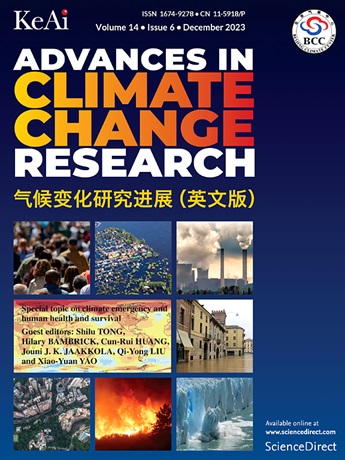Global prevalence of compound heatwaves from 1980 to 2022
IF 5.2
1区 地球科学
Q1 ENVIRONMENTAL SCIENCES
引用次数: 0
Abstract
Global warming has led to increasing occurrence of hot extremes, yet our understanding of the compound heatwaves (CHW) of both day and night—the most threatening and harmful type—remains limited. Here we use the air temperature from ERA5-Land datasets to analyze key characteristics of global CHW from 1980 to 2022. Our results demonstrate a pronounced increase in global CHW, with an annual cumulative intensity rising by 3.32 °C per decade (p < 0.001), approximately four times greater than the increases observed in individual heatwave types of daytime (0.73 °C per decade, p < 0.001) and nighttime (0.78 °C per decade, p < 0.001), respectively. High latitudes in the Northern Hemisphere, particularly the Arctic regions, have experienced the highest increases in CHW (>10 °C per decade), especially since 2005. Moreover, interannual variations of CHW are closely linked to major climate modes, displaying strong region-specific connections and varied lagged effect, particularly with ENSO and PDO in tropical regions. Altogether, these results reveal the unexpected prevalence of CHW in recent decades, emphasizing the urgent need to address its potential adverse impacts on human and ecosystem well-being.
1980年至2022年复合热浪的全球流行情况
全球变暖导致极端高温的发生越来越多,然而我们对白天和夜间的复合热浪(CHW)——最具威胁性和危害性的类型——的了解仍然有限。本文利用ERA5-Land数据集的气温,分析了1980 - 2022年全球CHW的关键特征。我们的研究结果表明,全球CHW显著增加,年累积强度每十年增加3.32°C (p <;0.001),大约是在个别白天热浪类型(0.73°C / 10年,p <;0.001)和夜间(每十年0.78°C, p <;分别为0.001)。北半球高纬度地区,特别是北极地区,经历了最高的CHW增加(每十年增加10°C),特别是自2005年以来。此外,CHW的年际变化与主要气候模式密切相关,表现出较强的区域关联性和不同的滞后效应,特别是与热带地区的ENSO和PDO。总之,这些结果揭示了近几十年来CHW的意外流行,强调了解决其对人类和生态系统健康潜在不利影响的迫切需要。
本文章由计算机程序翻译,如有差异,请以英文原文为准。
求助全文
约1分钟内获得全文
求助全文
来源期刊

Advances in Climate Change Research
Earth and Planetary Sciences-Atmospheric Science
CiteScore
9.80
自引率
4.10%
发文量
424
审稿时长
107 days
期刊介绍:
Advances in Climate Change Research publishes scientific research and analyses on climate change and the interactions of climate change with society. This journal encompasses basic science and economic, social, and policy research, including studies on mitigation and adaptation to climate change.
Advances in Climate Change Research attempts to promote research in climate change and provide an impetus for the application of research achievements in numerous aspects, such as socioeconomic sustainable development, responses to the adaptation and mitigation of climate change, diplomatic negotiations of climate and environment policies, and the protection and exploitation of natural resources.
 求助内容:
求助内容: 应助结果提醒方式:
应助结果提醒方式:


